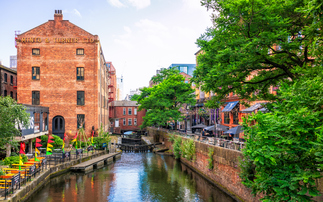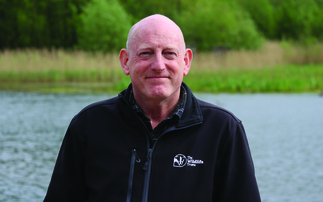Partner Insight: Atkins' Kevin Skinner, David Gasca-Tucker, Stephen Barge, and Claire Wansbury explain the benefits of nature-based solutions and natural capital to benefit nature as well as climate restoration
In May, as it was reported that the world's glaciers are melting at an accelerated rate, the Prime Minister Boris Johnson announced an acceleration of the UK's climate change commitments ahead of COP26, now pledging a 78 per cent reduction in emissions by 2035 from 1990 levels.
In the same month, President Biden announced ambitious emissions targets for the US, and called this a "decisive decade" for tackling climate change. Now, more than ever, there seems to be a sense of urgency among governments and world leaders to make the big changes needed to bring the climate crisis under control.
And if we are to meet increasingly ambitious environmental targets, and ensure we are doing all we can to create a sustainable future for our planet, a completely fresh approach is needed.
Atkins' long history in catchment management has opened our eyes to the value of working in partnership with nature across all our projects. This, we believe, is the key to making real progress when it comes to climate change.
A multi-benefit approach
By considering and building natural processes into sustainable and adaptable engineering approaches, we can address existing challenges such as flood resilience, biodiversity loss and water quality issues, while also considering the bigger picture and making realistic strides towards broader environmental improvements that deliver community and social value.
A natural capital approach is key to this; understanding the natural stocks and assets around us and what they are worth to society. In this way we can facilitate positive management, enhancement and design of forward-looking blue-green infrastructure projects that work in partnership with nature in the most effective way possible. Atkins' Natural Capital Studio accounting tool automatically calculates natural capital across a range of scenarios to make it easier to assess and integrate this approach into project planning and design, supporting sustainability targets and maximising the value of nature-based solutions.
Atkins has a long history of designing nature-based solutions that make real improvements to habitat quality across the water environment. Recently, we worked with the Environment Agency on Defra Natural Flood Management trials on the River Soar. The main objective was to reduce the risk of flooding downstream - which we did through a variety of natural measures - but the approach also highlighted opportunities to maximise natural capital and ended up achieving far broader benefits. By slowing the flow and storing water on the floodplain, the resulting wetland sequestered carbon, trapped sediment and nutrients, and created a rich habitat for a range of wildlife. In some cases, these additional benefits can significantly exceed the value they provide in terms of their original objective, something that until recently was difficult to quantify.
Many stakeholders are looking at projects like the River Soar and realising the real potential of nature-based solutions to maximise the natural capital value of their assets, marking the start of an industry and societal shift to build natural capital thinking and principles into the entire lifetime of a project.
Tools to work with nature
Unlike traditional engineering solutions which are designed to achieve formulaic outcomes, nature-based solutions are not set in stone and require an adaptive, and dynamic, approach to delivery. They are designed to evolve over time, so it's not clear what future adaptations might be required.
At Atkins, we've developed digital tools that allow us to assess different scheme evolution scenarios to increase confidence in the effects and value of nature-based solutions. Our NFM (Natural Flood Management) Studio uses detailed modelling to identify optimum locations for interventions and simulates the effectiveness of various NFM solutions in rural environments. Our SuDs (Sustainable Drainage Systems) Studio automates the assessment phase of drainage projects and identifies blue-green infrastructure opportunities in urban environments. Both tools have a strong foundation in digital mapping, using the increasing availability of open source data to drive innovation in environmental thinking and scheme design.
Using these tools to optimise value, nature-based solutions can become much more attractive. By providing tangible calculations and accurate scenario modelling, technology can encourage greener choices and decision making, avoiding costly wrong turns and delivering better value for public money.
The whole package
It's clear that to tackle the current effects of climate change and limit future damage, we need to use all the tools at our disposal. This holistic approach is the key to smart implementation of carbon reduction and nature-based solutions across everything we do. Not only will this drive down emissions associated with the manufacture and transport of materials such as concrete and steel, but it also has promising potential regarding carbon sequestration.
In contrast to the challenge of adapting traditional solutions, nature-based approaches offer an agile approach to managing an uncertain future; providing the flexibility to evolve with nature as the uncertain effects of climate change take hold.
In addition to carbon reduction, working with nature in the broadest possible sense creates boundless opportunities for positive enhancement relating to the full range of environmental and societal benefits, which when combined with innovation and smart technology, gives us the complete package we need for the future. Delivery can be undertaken locally and scaled up accordingly to deliver more integrated benefits.
By allowing nature to lead the way, our relationship becomes cyclical rather than linear: nature benefits from us, and we benefit from nature - a truly sustainable approach with real potential to turn things around for the planet and its inhabitants. There is no time to lose.
Kevin Skinner is principal geomorphologist, David Gasca-Tucker a principal hydrologist, Stephen Barge the head of service line, and Claire Wansbury an associate director at multinational engineering, design and project management firm Atkins.
This article was sponsored by Atkins.







